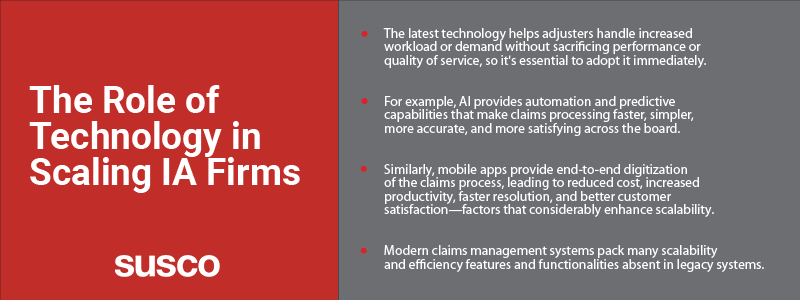Embracing AI, mobile apps, and modern claims management systems as a growth lever can mean all the difference for your business.

Insurance adjusting is a competitive industry, and client demands constantly change. Firms seeking to scale their business must apply foresight, strategy, and the right technology. It’s the only guarantee they’ll process claims efficiently while maintaining quality, competitiveness, and customer satisfaction.
But what technologies make the most impact? How do they drive growth? Most importantly, how can insurance adjusters (IAs) maximize benefits? Here’s all you need to know:
Technology solutions driving growth for IAs
1. Artificial intelligence
Of the innovations driving growth in insurance, none is more impactful and ubiquitous than artificial intelligence (AI). As an enabler of automation and a predictive tool, AI makes claims processing faster, simpler, more accurate, and more satisfying across the board.
To better understand how and where to integrate AI in claims processing, consider the current drivers of claims quality. As it stands, the contact, investigation, and settlement phases provide the greatest opportunity to improve claims quality and scalability.
Many insurers still manually manage these phases using outdated systems, which is a big mistake. A manual approach slows claims processing and increases the risk of errors and duplication. Luckily, strategic AI and data modeling implementation can help bridge the gap.
For example, adjusters can integrate the Internet of Things (IoT) at the first notice of loss (FNOL) for real-time notification of incidents via a mobile app. Additionally, chatbots can aid information dissemination, gathering, reporting, and repetitive administrative tasks. For instance, adjusters can use them as the first point of contact to inform claimants about required documents and steps for claims submission.
AI adoption in claims investigation and coverage determination also provides an opportunity to boost productivity and expedite cycle times. For example, adjusters can instantly extract context and meaning from FNOL documents using optical character recognition (OCR). Similarly, they can leverage computer vision to interpret intelligent drones’ visual inputs and create real-time damage estimates.
Beyond data capture and interpretation, AI algorithms can infer previously unknown claim characteristics, such as fraud patterns, to protect the company as it grows. Plus, AI can help segment cases to optimize downstream handling. For example, based on predetermined rules, AI can automate straightforward cases while routing complex ones requiring human adjudication to the best-suited handler. This considerably improves resolution speed and accuracy, and it’s possible to provide same-day settlement in some cases.
When adjusters use AI tools to eliminate redundant tasks and introduce efficiencies, they free claims handlers to do higher-value work aligned with their key competencies. This puts the organization at a significant advantage as it scales.
2. Mobile apps
Workforce and customer-facing mobile apps must be part of your tech stack to scale smoothly. These provide the immediacy, accuracy, transparency, communication, and end-to-end digital capabilities needed to thrive in today’s digital-first landscape.
As most adjusters can attest, information gathering is one of the biggest hurdles in claims processing. Yet, collecting as much data as possible during submission is crucial since even small omissions can delay resolution.
The problem with traditional claims submission is that it requires many photographs and note-taking. While these tasks are simple, keeping track of everything can overwhelm claimants and contribute to them leaving out vital details.
Another challenge is claim handlers’ back-and-forth trips between the field and the office. A lot of time and effort is expended in accessing, uploading, and manually tracking data instead of actually servicing claims.
Here, mobile app integration makes all the difference.
With a custom, intuitive, self-service mobile app, IA firms can seamlessly guide claimants through each step and requirement to capture all relevant data at first contact. This information is instantly available to claim handlers via their workforce app, allowing them to validate claims and input estimates onsite. Managers receive real-time updates and spend less time tracking claims. Claimants, too, can view the status of their claims at any time. The result is more claims processed daily and higher customer satisfaction.
3. Modern claims management systems
Modern claims management systems (CMSs) pack many scalability and efficiency features and functionalities absent in legacy systems. For starters, they are readily compatible with cutting-edge technologies like AI, meaning you can start reaping benefits immediately. The interoperability of modern CMSs also means that communicating with other systems in your digital ecosystems won’t be a problem.
Because modern CMSs are highly configurable, IA firms can tailor them to specific business requirements. They can create and manage custom workflows, define user roles and permissions, tighten security, integrate with third-party applications they use, and more. The flexibility and agility afforded by modern CMSs means IA firms can scale confidently.
Another business justification for upgrading legacy systems is to take advantage of advanced analytics and reporting capabilities. Modern CMSs can analyze data from disparate sources and provide real-time insights into claim status, trends, and performance. Equipped with this data, adjusters and managers can swiftly act to improve processes, optimize resource allocation, and achieve overall better outcomes.
Leverage technology as a growth lever
Technology will continue to shape the insurance sector. Adjusters seeking to scale their business and influence must integrate AI into workflows, leverage mobile apps for end-to-end claims digitization, and replace aging systems with more capable ones. Moving quickly is paramount to avoid losing out to early adopters.
Don’t have the internal resources to evolve capabilities? No problem. Susco can be your strategic partner. For over 17 years, we’ve helped our clients stay ahead of the digital curve with responsive technology solutions. Whether you need to build commercial and workforce mobile apps, client portals, custom internal business software, or upgrade legacy systems, we’ve got you covered.
At Susco, we appreciate that while access to the latest technology is crucial, it must be usable to maximize benefits. That’s why our experts build software for humans first.
Sounds like what you’re looking for? Book a free one-hour consultation to learn more.